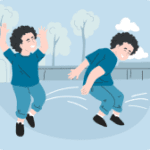Best Night Light Color for Baby
How Red Light Can Benefit Your Child’s Sleep
Welcoming a new baby into the home is a joy like no other, but as many parents quickly learn, it also introduces the challenge of ensuring your little one gets the quality sleep they need. Night lights often become an essential part of the nursery. The color of light you choose can have a significant impact on your child’s sleep – whether you have a new baby or a child experiencing heightened sensitivity to environments, including light sources. Have you considered red light? Let’s learn more.
Can Red Light Stimulate Melatonin?
One of the key benefits of using red light as a night light in your child’s room is its potential to stimulate the production of melatonin—the sleep hormone. As darkness sets in, your brain will release more melatonin naturally relative to when you’re exposed to more light. The unique wavelengths of red light encourage the body’s natural melatonin production, aiding in a smoother transition to sleep.
Easing Sleep Inertia for a Better Morning
There’s nothing quite like the disorienting grogginess that sleep inertia brings upon waking. It can not only affect you—the sleep-deprived parent—but it can also influence your child’s mood and alertness. A 2019 study suggests that red light exposure through closed eyelids might help to reduce sleep inertia, making those early morning wake-ups a bit more bearable.
Gentler on the Eyes for Nighttime Navigation
Navigating a nursery in the dark can be a challenging task. Unlike the stark glare of white light, which leaves you blinking and squinting, red light is gentle and non-glaring, allowing for better visibility without disruption. This non-intrusive illumination doesn’t only apply to bedside lamps; red tones in night lights can help you care for your infant without fully waking either of you, preserving the peaceful sleep environment.
Shifting Away from Blue Light for Healthier Circadian Rhythms
With screens nearly essential in our lives these days, blue light is hard to escape. It’s beneficial during the day, keeping us alert and awake. However, blue light at night can be a sleep stealer, interrupting the production of melatonin and therefore, impacting sleep quality. Unlike blue light, red light does not have the same effect on our sleep cycle and is actually conducive to maintaining a healthy circadian rhythm, according to this 2017 study.
To Consider: Can Red Light Help with Autism?
The focus on red light’s potential extends to its benefits for children on the autism spectrum, who may experience heightened sensitivity to their environments, including light sources. Integrating red light can create a soothing atmosphere that may reduce sensory overload and support better sleep patterns. Research is currently being conducted into this topic.
Sleep Tips for Optimal Light Exposure
With all this in mind, here are some actionable tips to enhance sleep quality for you and your baby:
At Night:
- Use black out curtains in your nursery to block all external light sources.
- Opt for a night light that emits a soft red glow that won’t interfere with sleep.
- Remove any other artificial light or swap them for those with night modes that have less impact on the sleeping environment.
- Dim lighting to warmer settings and be screen-free about 30 minutes to an hour before bed to help your mind and your baby’s mind ease into sleep mode.
During the Day:
- Open blinds in the morning and welcome the sunshine light to help regulate both your and your baby’s internal clock.
- If you’re rising before the sun, switch on low-wattage, warmer-toned lights that won’t shock the system.
- Keep natural light a part of your days to boost alertness and aid in overall well-being, mood, and alertness.
Redefining Bedtime: Why Red Light Makes All the Difference
The shift to red light in your child’s room isn’t just about myths; it’s backed by science with so many wonderful benefits. With the advent of red light technologies, parents now have an effective tool in creating a sleep-conducive environment. Whether it’s supporting melatonin production, reducing sleep inertia, or aiding children on the autism spectrum, the benefits of red light night lights can be a game-changer. Nurturing sleep habits now can have a lasting impact on your child’s growth and development. So, go ahead, switch on the red, and help improve sleep for you and your child.












 Speech Therapy
Speech Therapy Physical Therapy
Physical Therapy Occupational Therapy
Occupational Therapy

